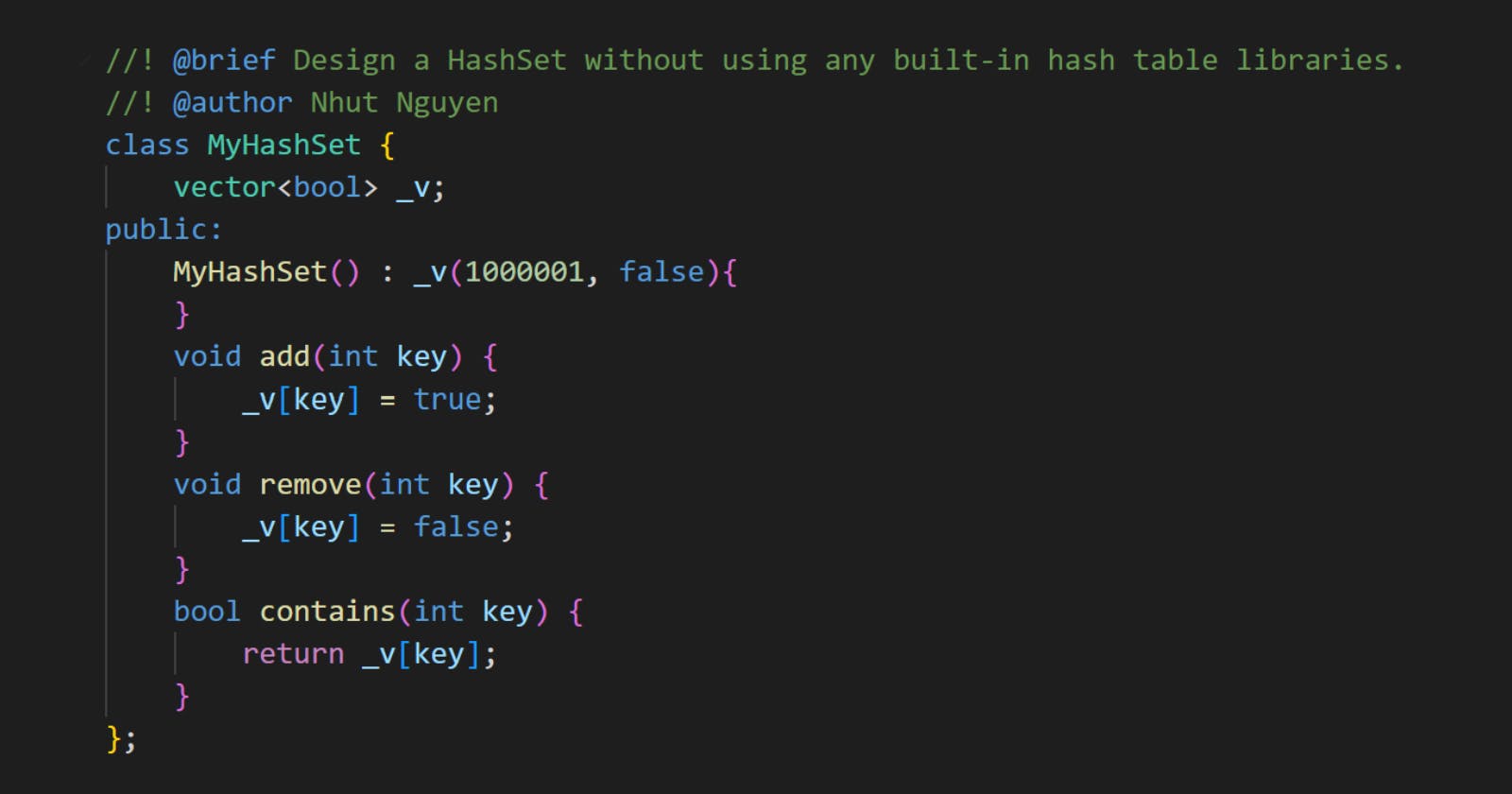Problem statement
Design a HashSet without using any built-in hash table libraries.
Implement MyHashSet class:
void add(key)Inserts the valuekeyinto the HashSet.bool contains(key)Returns whether the valuekeyexists in the HashSet or not.void remove(key)Removes the valuekeyin the HashSet. Ifkeydoes not exist in the HashSet, do nothing.
Example 1
Input
["MyHashSet", "add", "add", "contains", "contains", "add", "contains", "remove", "contains"]
[[], [1], [2], [1], [3], [2], [2], [2], [2]]
Output
[null, null, null, true, false, null, true, null, false]
Explanation
MyHashSet myHashSet = new MyHashSet();
myHashSet.add(1); // set = [1]
myHashSet.add(2); // set = [1, 2]
myHashSet.contains(1); // return True
myHashSet.contains(3); // return False, (not found)
myHashSet.add(2); // set = [1, 2]
myHashSet.contains(2); // return True
myHashSet.remove(2); // set = [1]
myHashSet.contains(2); // return False, (already removed)
Constraints
0 <= key <= 10^6.At most
10^4calls will be made toadd,remove, andcontains.
Solution 1: Store the keys
The simplest way is using a container to store the keys so you can identify if a key belongs to the HashSet or not.
Code
#include <iostream>
#include <vector>
using namespace std;
class MyHashSet {
vector<int> _v;
public:
MyHashSet() {
}
void add(int key) {
if (!contains(key)) {
_v.push_back(key);
}
}
void remove(int key) {
auto it = _v.begin();
while (it != _v.end()) {
if (*it == key) {
_v.erase(it);
return;
} else {
it++;
}
}
}
bool contains(int key) {
for (int a : _v) {
if (a == key) {
return true;
}
}
return false;
}
};
int main() {
MyHashSet m;
m.add(1);
m.add(2);
cout << m.contains(1) << endl;
cout << m.contains(3) << endl;
m.add(2);
cout << m.contains(2) << endl;
m.remove(2);
cout << m.contains(2) << endl;
}
Output:
1
0
1
0
Complexity
Runtime:
O(N)for all methods, whereNis the number of values in the HashSet.Extra space:
O(N).
Solution 2: Marking the keys
In this problem, the HashSet does not have anything other than methods add, remove and contains, which only check whether a key exists in it or not.
With this purpose you can simply mark the keys without storing them.
Code
#include <iostream>
#include <vector>
using namespace std;
class MyHashSet {
vector<bool> _v;
public:
MyHashSet() : _v(1000001, false){
}
void add(int key) {
_v[key] = true;
}
void remove(int key) {
_v[key] = false;
}
bool contains(int key) {
return _v[key];
}
};
int main() {
MyHashSet m;
m.add(1);
m.add(2);
cout << m.contains(1) << endl;
cout << m.contains(3) << endl;
m.add(2);
cout << m.contains(2) << endl;
m.remove(2);
cout << m.contains(2) << endl;
}
Output:
1
0
1
0
Complexity
Runtime:
O(1).Extra space:
O(1).
References
Thanks for reading. Feel free to share your thought about my content and check out my FREE book “10 Classic Coding Challenges”.

